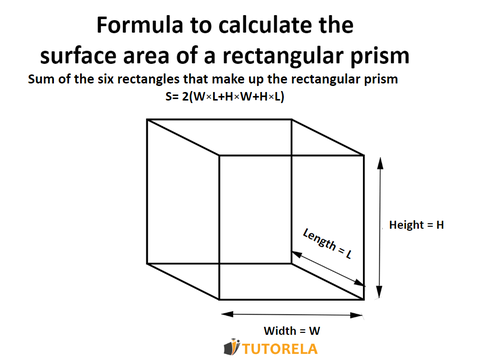Rectangular Prisms are made up of different rectangles. When faced with an exercise or exam that asks you to calculate the surface area of a rectangular Prism, use the formula below.
Surface Area of a Cuboid Practice Problems & Solutions
Master surface area of cuboid calculations with step-by-step practice problems. Learn formulas, solve real-world applications, and boost your geometry skills today.
- Apply the surface area formula SA = 2(lw + lh + wh) to rectangular prisms
- Calculate surface area using length, width, and height measurements accurately
- Solve real-world problems involving boxes, containers, and packaging materials
- Convert between different units of measurement in surface area calculations
- Identify and correct common mistakes in cuboid surface area problems
- Build confidence with progressively challenging surface area word problems
Understanding Surface Area of a Cuboid
The formula: how to calculate the area of a rectangular prism (rectangular orthohedron)?
S= surface area

Practice Surface Area of a Cuboid
A cuboid has a surface area of 102.
Calculate X.
Examples with solutions for Surface Area of a Cuboid
A cuboid has the dimensions shown in the diagram below.
Which rectangles form the cuboid?
Every cuboid is made up of rectangles. These rectangles are the faces of the cuboid.
As we know that in a rectangle the parallel faces are equal to each other, we can conclude that for each face found there will be two rectangles.
Let's first look at the face painted orange,
It has width and height, 5 and 3, so we already know that they are two rectangles of size 5x6
Now let's look at the side faces, they also have a height of 3, but their width is 6,
And then we understand that there are two more rectangles of 3x6
Now let's look at the top and bottom faces, we see that their dimensions are 5 and 6,
Therefore, there are two more rectangles that are size 5x6
That is, there are
2 rectangles 5X6
2 rectangles 3X5
2 rectangles 6X3
Answer:
Two 5X6 rectangles
Two 3X5 rectangles
Two 6X3 rectangles
Look at the the cuboid below.
What is its surface area?
First, we recall the formula for the surface area of a cuboid:
(width*length + height*width + height*length) *2
As in the cuboid the opposite faces are equal to each other, the given data is sufficient to arrive at a solution.
We replace the data in the formula:
(8*5+3*5+8*3) *2 =
(40+15+24) *2 =
79*2 =
158
Answer:
158
Identify the correct 2D pattern of the given cuboid:
Let's go through the options:
A - In this option, we can observe that there are two flaps on the same side.
If we try to turn this net into a box, we should obtain a box where on one side there are two faces one on top of the other while the other side is "open",
meaning this net cannot be turned into a complete and full box.
B - This net looks valid at first glance, but we need to verify that it matches the box we want to draw.
In the original box, we see that we have four flaps of size 9*4, and only two flaps of size 4*4,
if we look at the net we can see that the situation is reversed, there are four flaps of size 4*4 and two flaps of size 9*4,
therefore we can conclude that this net is not suitable.
C - This net at first glance looks valid, it has flaps on both sides so it will close into a box.
Additionally, it matches our drawing - it has four flaps of size 9*4 and two flaps of size 4*4.
Therefore, we can conclude that this net is indeed the correct net.
D - In this net we can see that there are two flaps on the same side, therefore this net will not succeed in becoming a box if we try to create it.
Answer:
What is the surface area of the cuboid in the figure?
To solve this problem, we'll follow these steps:
- Step 1: Identify the dimensions of the cuboid.
- Step 2: Apply the surface area formula for a cuboid.
- Step 3: Calculate and interpret the result.
Now, let’s work through each step:
Step 1: We have the dimensions as follows:
- Length () = 72
- Width () = 17
- Height () = 14
Step 2: Apply the surface area formula:
The total surface area is calculated using the formula:
Substitute the given dimensions into the formula:
Step 3: Calculate each multiplication and sum them up:
- Calculate
- Calculate
- Calculate
Now substitute back into the equation:
Add the products:
Finally, multiply by 2:
Therefore, the surface area of the cuboid is .
Answer:
4940
Calculate the surface area of the orthohedron below using the data in the diagram.
To solve this problem, we'll utilize the formula for the surface area of a cuboid. The steps are as follows:
- Step 1: Identify the dimensions from the problem. The dimensions provided are , , and .
- Step 2: Apply the surface area formula for a cuboid. The formula is: where , , and are the dimensions of the cuboid.
- Step 3: Substitute the known values into the formula:
- Step 4: Calculate each term inside the parentheses: - - -
- Step 5: Sum the results from Step 4:
- Step 6: Multiply the sum by 2 to find the total surface area:
Thus, after performing the necessary calculations, the surface area of the orthohedron is square units.
Answer:
62